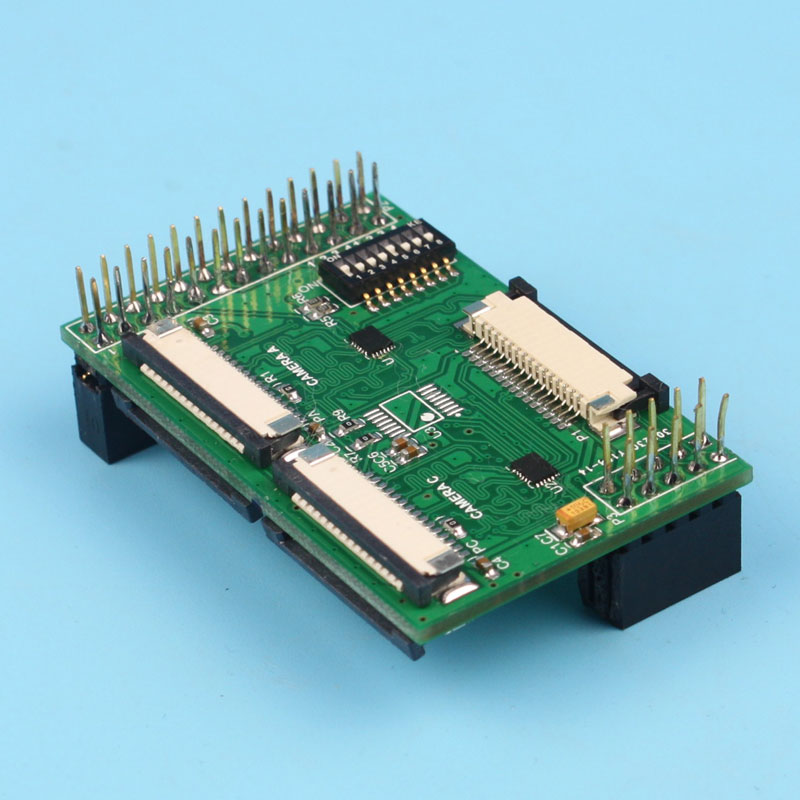Description
ArduCAM Multi-Camera Adapter Board for Raspberry Pi:
The Raspberry Pi multi camera adapter module (v2.1 – B0120 and doubleplexer – B016601) is a shield designed for connecting more than one camera to a single CSI camera port on Raspberry Pi A/B/B+ or Pi 2 board. One multiplexer adapter board can connect four (B0120) or two (B016601) Raspberry Pi cameras – both OV5647 V1 and IMX219 V2 (contact ArduCam tech support for assistance with other Raspberry Pi boards).
The original multi camera adapter module (v1.0 – B0069) which only worked with OV5647, has been discontinued and is no longer available, but the technical information required for setup is described below.
Note: With any of these boards, only one camera is active at a time.
Note: The Raspberry Pi multi camera adapter board is a nascent product that may have some stability issues and limitations because of the cable’s signal integrity and Raspberry Pi’s closed source video core libraries, so use it at your own risk.
Features (Multiplexer v1 and v2.1):
- Accommodate 4 Raspberry Pi cameras on a single multi-camera adapter board (B0069 and B0120)
- Stackable up to 4 adapter boards (B0069 only)
- 3 GPIOs required for multiplexing on one adapter board, 5 GPIOs for two adapter board, 9 GPIOs for four adapter board (B0069)
- All camera ports use FFC (flexible flat cable) connectors
- DIP switches for easy stack up configuration
- Supports Raspberry Pi A/B/B+ and Pi 2/3/4 (Raspian 9.8 and earlier – v1 and v2.1), also RPi Zero (B016601 only)
- Supports Raspberry Pi V1 (OV5647) and V2 (IMX219 – B0120 and B016601) cameras
Pin Configuration (Multiplexer v1 only):
DIP switches are used here for easy stack up configuration. When only one multi camera adapter board is used, the switches 1 and 5 should be switched to ON position. If two multi camera adapter boards are used, the downside board should be switched 1 and 5 to ON and upside board should be switched 2 and 6 to ON position, and if 3 or 4 multi camera adapter boards are used together each board layer should be configured as the Table 1 shown.
Operation (Multiplexer v1 and v2.1):
For proper operation, only one camera should be enabled at a time. In the case where only one multi camera adapter board is used, driving Pin12 HIGH (Enable 2) and driving Pin11 (Enable 1) and Pin7 (Selection) to LOW enables camera A on the adapter board. Please refer the Table 1 for camera selection configuration to enable cameras B, C and D. To disable all cameras on one adapter board, Enable 1 and Enable 2 signals should be toggled HIGH. Care should be taken that it is not allowed to drive the Enable 1 and Enable 2 LOW at the same time. When connecting more than two multi-camera adapter boards (v1 only), only one of the cameras can be enabled by enabling the desired camera on one adapter board, and disabling all the cameras on the rest of adapter boards.
Table 2 – Camera Selection Configuration
| Camera Selection Configuration | Selection | Enable 1 | Enable 2 |
| A | 0 | 0 | 1 |
| B | 1 | 0 | 1 |
| C | 0 | 1 | 0 |
| D | 1 | 1 | 0 |
| No Camera | X | 1 | 1 |
| Error | X | 0 | 0 |
(X: don’t care)
Software Demonstration (Multiplexer v1 and v2.1):
Before using this product, the required “python-rpi.gpio” dependency must be installed with this command from the Terminal:
sudo apt-get install python-rpi.gpioThen run the following Python code for a quick demo.
import RPi.GPIO as gp
import os
gp.setwarnings(False)
gp.setmode(gp.BOARD)
gp.setup(7, gp.OUT)
gp.setup(11, gp.OUT)
gp.setup(12, gp.OUT)
gp.setup(15, gp.OUT)
gp.setup(16, gp.OUT)
gp.setup(21, gp.OUT)
gp.setup(22, gp.OUT)
gp.output(11, True)
gp.output(12, True)
gp.output(15, True)
gp.output(16, True)
gp.output(21, True)
gp.output(22, True)
def main():
gp.output(7, False)
gp.output(11, False)
gp.output(12, True)
capture(1)
gp.output(7, True)
gp.output(11, False)
gp.output(12, True)
capture(2)
gp.output(7, False)
gp.output(11, True)
gp.output(12, False)
capture(3)
gp.output(7, True)
gp.output(11, True)
gp.output(12, False)
capture(4)
def capture(cam):
cmd = "raspistill -o capture_%d.jpg" % cam
os.system(cmd)
if __name__ == "__main__":
main()
gp.output(7, False)
gp.output(11, False)
gp.output(12, True)
Use the GPIOs according to the Table 1 and Table 2 configuration, to switch between different cameras to take photos or videos; use raspistill or raspivid commands to take photos or videos.
Package Includes:
-
ArduCAM Multi-Camera Adapter Board for Raspberry Pi (qty 1)
- Note: The Raspberry Pi Board and Mini Raspberry Pi cameras are NOT INCLUDED

Reviews
There are no reviews yet.